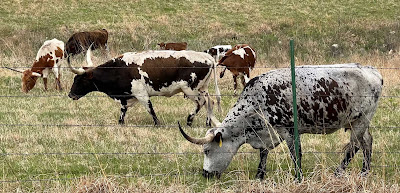
I risk being accused of a new shallow approach to the intellectual content of this blog, and perhaps of random promotional content and motivation, but while the iron is hot and before the weather turns hotter, I want to place another Manhattan attraction on the radar of those who may visit. Appearing every day, approximately 364 times more frequently each year than the Manhattan Area Garden Tour, is the most excellent display at the K-State Gardens of the
John E. Tillotson Sr. Adaptive/Native Plant Garden.

Those of you who are native plant enthusiasts should plan a whole trip around this garden because it is, in my experience, unequaled for the use of native prairie forbs in a garden design. Here columbines, milkweed, echinacea, butterfly milkweed, yucca, coreopsis, penstemon, prairie larkspur and evening primrose, all mix in glorious harmony and mature abundance. The display is at its peak now, in early June.
This view, down the long axis of the garden looking towards the old conservatory will give you an idea of the flowing masses of perennial forbs that make up the display garden. Coreopsis in the foreground and Pale Purple Coneflower (
Echinacea pallida) in the background provide the basis of a pastel palette for your pleasure.

I often find myself trying to take a peerless photo of a group of these echinacea in the fruitless pursuit of photographic perfection. It is most definitely an exercise in frustration for an amateur like myself, but there are lots of opportunities here to experiment with depth of field, framing, focus and shadows. The hardest choice for me is always where the focus should be; the plant in the center or the plant closest to the lens? Sometimes, I capture a pretty nice image, only to realize that, on closeup, one of the flowers is damaged or blemished, marring the effect of the photo.

The honeybees were going crazy over this newly-opened Butterfly Milkweed (
Asclepias tuberosa) during the Garden Tour. The whole area was alive with bees moving quickly from bloom to bloom, humming with excitement and loud enough to drown out the noise from nearby traffic. Does anyone else wonder, while viewing closeup photos of bees, how they ever lift those pudgy bodies with such small delicate wings?

I assume this is a form of Showy Evening Primrose, (
Oenothera speciosa), but I've never seen it quite so blazenly pink in the wild. I don't know if it is a collected species or a commercial cultivar, but the delicate petals laugh in the face of the hottest sun. According to Internet sources, some of the Showy Primrose that start out pure white age to pink, like these, while others stay the pure white that I associate with the wild species.

Years ago, walking around the K-State Garden, I noticed an enticing sweet scent that seemed to be coming from some 6 feet tall, large-leaved plants. In an embarassing display of naivete and stupidity, I asked what they were, only to find out that they were Common Milkweed (
Asclepias syriaca), the same weeds I'd grown up with in Indiana and fought hand-to-hand in my father's garden and fields. They are a perfect example of how blind we can be to the good qualities of a plant that pops up in the wrong place. I had no idea Common Milkweed was fragrant, nor that it would grow so tall if left alone.
I'll leave you with the sight of these bronze wildcats (the K-State mascot, for those who were unaware), which languidly observe the garden visitors during the day and come alive to patrol the native garden at night. Sited in Phase I of the garden, right next to busy Denison Avenue, you can tune out the traffic and suddenly you're out in the middle of the Flint Hills. I know that some gardeners (yes, I'm talking to
you, Benjamin Vogt) believe that such an ethos is the only way we should be gardening. When I view the success of this design, here at the Kansas State University gardens, I can only agree and encourage everyone to drop by and leave with some new gardening ideas.
.jpg) Thankfully, on a brighter note, even a two mower-wide swath didn't reach these fledgling Liatris further down the road. I can only hope to see these mature and spread across the untouched prairie of our neighborhood.
Thankfully, on a brighter note, even a two mower-wide swath didn't reach these fledgling Liatris further down the road. I can only hope to see these mature and spread across the untouched prairie of our neighborhood..jpg)
.jpg)
.jpg)
.jpg)
.jpg)
.jpg)
.jpg)
.jpg)
.jpg)
.jpg)
.jpg)


.jpg)
.jpg)
.jpg)
.jpg)




























.jpg)
.jpg)
.jpg)
.jpg)
